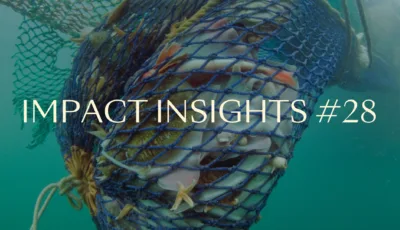Shifting paradigms: Impact investing is here to stay

More capital is heading into impact investing - but it has yet to hit the speed and scale we need. Rapidly changing paradigms can help ensure that it’s not too little, too late. We are gaining confidence in financial returns while realizing we can’t afford to let climate change spiral out of control. Combined with the radical increase in sustainability transparency, this may fuel exponential growth in impact capital.

From niche to mainstream
Money is power. And this power can be a force of change in an era of unprecedented challenges for humanity.
For many asset owners, the opportunity to help solve the largest problems of modern society is a motivation to move into impact investing alone. But for the bulk of returns-driven capital sources, there is still the misconception that impact investing can’t provide strong returns. It’s time to debunk the myth so we can mobilize more of this capital, moving impact investing from a niche to the mainstream. We depend on this catalytic shift in the financial system to halt climate change, loss of natural capital and create a livable future.
Fortunately, impact investing is already showing signs of long-term growth and widespread adoption. According to a survey of investor sentiment by Morgan Stanley, over half of individual investors plan to increase their sustainable investments this year, and 77% express interest in sustainable investing. Although sustainable investing spans a significantly broader scope than impact investing, this still reasonably translates into a maturation and growing interest in investments that bring people and the planet into the equation. That’s good news for humanity.
Rapidly changing paradigms can help ensure that it’s not too little, too late.
Ongoing paradigm shifts may give impact investing a boost
1. We’re about to bust the myth that impact investing necessarily means inferior returns.
According to Global Impact Investing Network research, most impact investors target risk-adjusted, market-rate returns (74%). More interestingly, the research shows that the majority (79%) achieve their targeted returns. Previous research has also established that top-quartile impact funds targeting market-rate returns perform similarly to funds in conventional markets. This highlights that impact is an additional layer of competence required of investment managers. Just like in conventional investing, top-notch investment teams are crucial to achieving superior returns.
2. The cost of inaction is hitting us hard.
According to the Climate Policy Initiative (CPI), ensuring we stay within the 1.5°C limit defined by the Paris Agreement requires USD 266 trillion in climate financing. It would take exponential growth in impact investing to meet this capital need. However, can we, members of the global investor community, afford not to?
The amount of capital needed to fight climate change appears negligible compared to the CPI’s cost of a business-as-usual warming scenario. The CPI estimates the “cost of inaction” to be a mind-boggling USD 1,266 trillion in economic and social costs. If runaway global warming plays out, we’ll be confronted with direct losses from, e.g., reduced productivity and damages to assets from extreme weather events. Social costs will be incurred from negative health impacts linked to pollution, illnesses and heat, biodiversity loss, and increased conflicts due to migration, food insecurity, and water scarcity.
But climate change is starting to demonstrate its temper and destructive power, breaking all the wrong records: extreme heatwaves, wildfires, unprecedented flooding, droughts, and rising ocean temperatures. As climate change is no longer a faraway hypothetical event, people feel it creeping closer to their lives. This growing awareness and relevance drives popular demand for climate action and helps pull all the strings toward impact investing.
3. Transparency and accountability are gaining ground. How long will we accept investing that destroys our common good?
Today, asset managers investing without a sustainability angle have a limited obligation to disclose information about their investments' impacts and, hence, the potential cost they are incurring on society. This starkly contrasts the requirements for impact- and sustainability-oriented financial players to document their achievements.
How long will we accept investing that destroys our common good?
A range of conventional investments are causing massive negative impacts in the name of shortsighted returns. It’s about time we require all financial players to inform the public and investors of the scale of the damage they are responsible for.
Greenwashing remains a serious issue in our economy, and we’re right to address it. But even more so, we should be concerned with investments that are making our problems worse while flying under the radar. For how long will investors be allowed to keep investing in companies that destroy our environment and incur enormous losses on global societies? The lingering opacity around the negative impacts of conventional investing is a significant blocker for change in the financial system, and I don’t see it lasting.
As disclosure regimes tighten, we will likely view conventional investments in a different light. It is unlikely that we will continue to condone investments that are responsible for large-scale damage and costs to society. The recent market consultation on the Sustainable Finance Disclosure Regulation (SFDR) floated the idea that a minimum of disclosures should apply to all products. If implemented, that would put a foot in the door to a fairer and more transparent financial system, likely strengthening impact investing’s momentum.
How innovative finance can help
There is ample room for impact investing to grow. Of the estimated USD 440 trillion global stock of capital, around USD 30 trillion is mobilized in so-called “sustainable investing,” including the estimated USD 1,2 trillion allocated to impact investing.
By some estimates, impact investing will continue to grow at a double-digit compound annual growth rate until 2030. That’s not enough.
Mobilizing capital across asset classes is crucial to catalyzing change at scale
More actors in the impact space are realizing that mobilizing capital across asset classes is crucial to catalyzing change at scale. Most impact capital is still allocated in private equity and private credit, with other large asset classes needing to catch up in the number of players involved and the AUM allocated.
Investment managers play a crucial role in the growth of impact investing, as they raise capital from diverse sources and directly invest in the companies and projects that can solve our problems. An increasing number of emerging managers are also focusing on building out products across asset classes, tapping into the needs of more types of capital to attract them to impact.
Impact investing represents a paradigm shift in how we allocate capital and address global challenges. The confluence of growing trust in financial performance, rising awareness of climate and environmental urgencies, favorable regulatory development, and innovative finance gives us reason to be confident: Impact investing is here to stay. As asset managers, we are committed to seizing the unprecedented opportunity to take the lead in this change.
Onward and upward! The future is meaningful.
This article was first published as part of Norselab's 2023 Meaningfulness Report.


